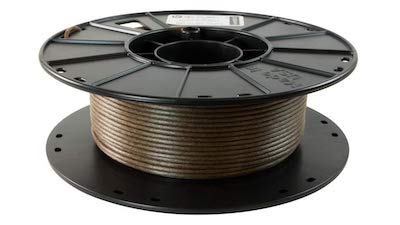Best Hemp Filament, How to Use Them, and Where to Buy
By now, we have written about nearly a dozen exotic filament materials, such as wood, graphite, and steel. Each of these exotic filaments introduce an entirely new dimension of aesthetics to your 3D print that you cannot attain with typical ABS or PLA. In this article, we put the spotlight on another of these exotic materials – hemp filaments. If hemp filaments sound like they are right up your alley, then read on for how they used and where they can be purchased.
What are hemp filaments?
Hemp filaments share much of the same characteristics as other specialty filaments. Similar to wood or carbon fiber filaments, hemp filaments are composed of a PLA filament infused with a finely ground solid material. In this case, about 10% of the filament material is composed of real hemp fibers.
Hemp fibers are some of the oldest and most widely used fibers due to its superior durability. It is derived from the cannabis plant and has had a long history of use in ropes, textile, and industrial materials. You can think of hemp filaments as the perfect marriage between old and new technology, resulting in a truly unique product.
What are the advantages and disadvantages of using hemp filaments?
A major benefit of hemp filaments, and probably one of the first things that will attract potential buyers to it, is the unique look it lends to 3D prints. Prints made with hemp filament come out with a characteristic finish and grain that comes naturally from the hemp fibers infused into the filament. They also come out with a dark brown color that is richer and bolder than those you can get with wood filaments.
Being largely PLA in composition, hemp filaments retain most of the characteristics that make PLA one of the top filaments of choice in the 3D printing industry. They are still quite easy to work with and print at relatively lower temperatures. Hemp filaments also exhibit a low tendency to warp or shrink and can be printed without a heated printing bed or cooling fan.
One major advantage of hemp filaments is the fact that it combines two ingredients that are fully biodegradable: PLA and natural hemp fibers. This fact makes buying and using hemp filaments a truly environmentally conscious decision. With hemp filaments, you will not need to worry about your misprints or wasted filaments, as you can safely dispose of them in landfills without worrying that it will take several lifetimes for them to decompose or that they will release toxic compounds into the soil.
On the other hand, hemp filaments suffer from much the same disadvantages as all other composite filaments. Since hemp filaments are infused with hard solid material, they can still lead to premature wear of your extruder due to the abrasiveness of the solid particles. The common advice to deal with this problem is to use an abrasive resistant material instead of the standard brass in your extruder. However, we find that a better and more sustainable solution is to use a wider diameter nozzle – a diameter of at least 0.5mm should perform exceptionally well.
Another common drawback when using composite filaments is their tendency to be more brittle than flexible, and the hemp filament is no exception. You will still have to ensure that there is a clear filament path from the spool to the extruder, which is free of sudden and sharp turns. Having your filament snap in the middle of the printing process is definitely bad news, as it might mean having to clean up your whole extruder set up and starting the print from scratch.
How do you use hemp filaments?
Since hemp filaments are made largely from PLA, most manufacturers recommend using printer settings that work best with or are close to those used for PLA. For instance, a printing temperature of 180 °C to 210 °C has been said to work best with hemp filaments. If you are having trouble with temperature settings, it is recommended to print at a temperature 10 °C below what you would normally use with PLA.
A heated bed is not necessary when printing using hemp filaments, but you may use one with a temperature set to about 45 °C to 50 °C. If you have a glass printing bed, then you will probably not need any adhesion aid. However, you may use a layer of Kapton tape to improve adhesion when using a heated printing bed.
The low tendency of hemp filament to warp or shrink means that you can print at relatively high speeds. Most manufacturers have claimed that hemp filament can be printed at speeds of up to 120 mm/s, but we recommend starting at a much lower setting of 60 mm/s and working your way up.
As already mentioned, we do not recommend using your standard brass hot end nozzle when printing using hemp filaments. The brass material can get worn down slowly over time which will eventually result in over-extrusion and poor quality prints.
Where can I buy hemp filaments?

If you are in the market for a hemp filament, then there really is only one name that stands above the rest. The Entwined Hemp-Infused Filament from 3DFUEL has become such a massively popular product that the manufacturer has just recently come out with a Version 2 of the filament. 3DFUEL has been known for coming up with creative and quirky filaments, and the Entwined is no exception.
The new formulation promises an overall better experience during printing and a better quality output. The particle size of the hemp fibers in the new filament has been reduced, allowing for an increase in the percentage of hemp material in the filament. Thus, the characteristic grain and finish of hemp has become even more pronounced. The Entwined filament remains fully biodegradable. It is compatible with most standard 3D printers including Makerbot and Lulzbot, among others.
The Entwined Hemp Filament is available in both 2.85mm and 1.75mm diameter. It can be purchased in either 500g or 1kg spools.
The final word
With all the new and fancy filaments being developed, it is truly a great time to be into 3D printing. 3DFUEL in particular has come up with really unusual filament materials, and one of these is the Entwined Hemp-Infused Filament. With the popularity of this product, it will not surprise us at all if similar products start popping up in the market. We think it is this spirit of innovation and creativity that allows us to push the boundaries of the possibilities of 3D printing.
If you are tired of printing using plain old PLA or ABS, and you have run through the gauntlet of the usual infused filaments, then perhaps it is time for you to start playing around with something more exotic. A hemp filament is a great place to start. It is not particularly challenging to use, and it produces prints that have a truly distinct look to them.
The great thing about it is that you do not have to feel bad about the environment should you make mistakes – disposing of your misprints is as easy as passing them on to your local landfill. It is perhaps this combination of creativity and environmental consciousness that will be the template for all future developments in the 3D printing filament industry.



The question is… can you smoke it? Lmao
you are when its printing :#D